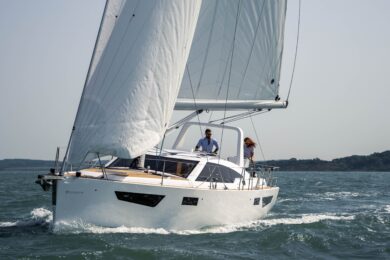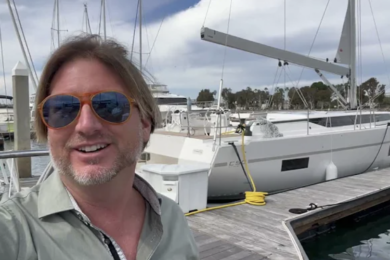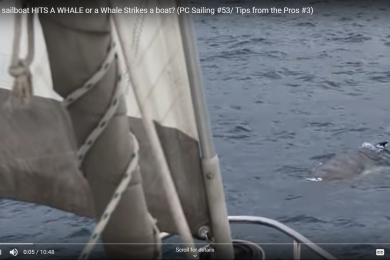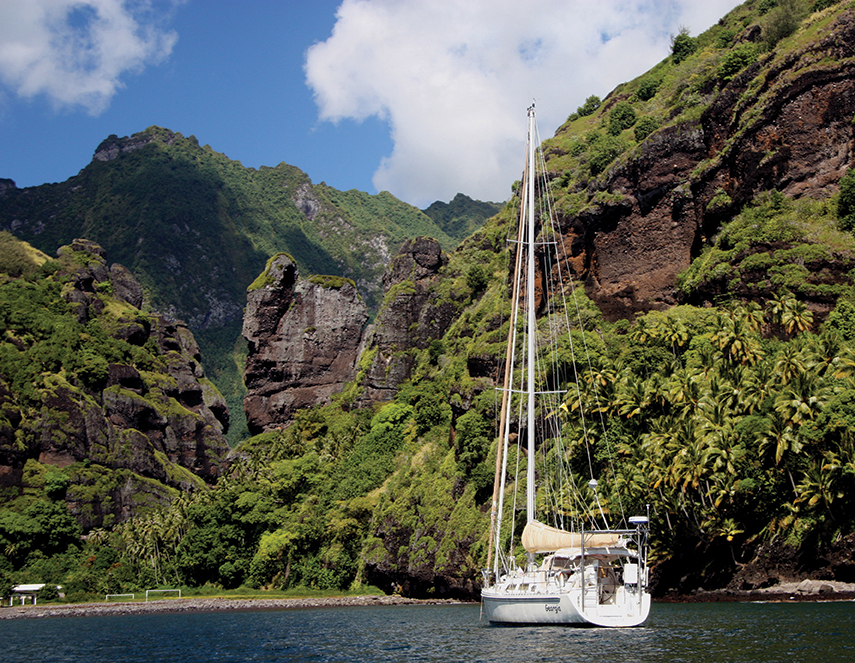Most of us who cross the Pacific to French Polynesia are doing the passage for the first time. It is the first step of the euphemistically named Pacific Puddle Jump or the Coconut Milk Run (published October 2015)
Whether you leave from Panama, Ecuador, Mexico, Costa Rica or the U.S. west coast it is a long passage that comes close to 3,000 miles. We’ve spent endless hours researching the passage issues, from pilot charts to weather routings to reading the long list of books and sailing blogs of those that came before us. Along with all this research, came months of getting the boat and its systems just right for a long passage, followed by a massive provisioning expedition—or two—to load up stores for the long passage and to cover some of the time in the reportedly expensive French Polynesian islands.
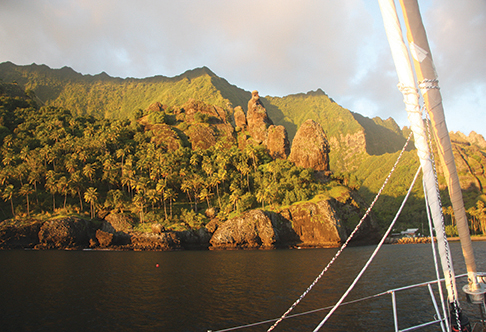
What I didn’t do before leaving was spend much time researching the Marquesas Islands. The Marquesas is the typical landfall for those crossing from the Pacific coast of North America down as far as Ecuador. A few boats go further south to enter French Polynesia in the Gambier islands—perhaps with a stop at Easter Island or Pitcairn on the way, if weather permits. The Marquesas are easy islands to navigate. A little prior information can make your landfall and your time in the Marquesas much more pleasurable.
The islands are tall, lusciously green, steep-to and volcanic. Clouds build up on the southeast sides and cover many of the peaks almost continuously. The prevailing winds are the southeast trades. Depending on the time of year and the whim of the wind gods, the winds may have some north or some south to the predominate easterlies. The wind strengths are not typically like the boisterous Caribbean trades that blow consistently for months on end in the high teens and low twenties. Wind speeds in the cruising season will typically be 12 to 15 knots with some days much lower and some days in the twenties.
Most cruisers leaving from the Americas arrive in the Marquesas sometime from February to May. The Marquesas are not really affected by cyclones, so showing up early in the season before the cyclone season is over should not pose a problem. The islands are located close enough to the equator that should a cyclone form in some strange El Nino-Global Warming conspiracy against sailors you could make for the north toward the equator and get in the band above five degrees South within one and half days where even the El Nino gremlins are unlikely to brew any mischievousness. There are a number of cruisers, mainly French, who spend the cyclone season in Baie de Taiohae, Nuka Hiva, the main bay in Nuka Hiva. The Tuamotos, the next group of islands to the southwest, are affected by cyclones and are too far to the south to leave any easy escape toward the equator. They are better left until after the cyclone season. It is generally considered to be over by May 1st. That said, a number of the large world rallies, including the World Arc and the Blue Planet Odyssey, travel through the Tuamotus in early April.

WHICH ISLAND FOR YOUR LANDFALL?
The Marquesas are oriented in a southeast to northwest line. The main southern islands consist of Hiva Oa, Tahuata and Fatu Hiva. The primary northern islands are Nuka Hiva, Ua Pou and Ua Huka. From Fatu Hiva in the south to Nuka Hiva in the north it is about 125 miles. You’ll get used to the names once you get a little closer to needing to know the differences between islands. The pronunciations are generally like they are phonetically spelled, with the syllables being pronounced shortly. Ua Pou is pronounced, at least by non-locals, as Wah Pooh. Hiva Oa as Eva Oh-ah.
There are three islands that have a gendarmerie (aka police station) available for clearing in: Hiva Oa, Ua Pou and Nuka Hiva. Because of the prevailing winds, the preferred place for a landfall would be Fatu Hiva in the south. This also allows you to visit all of the other islands without any sailing upwind in normal seasonal conditions. Unfortunately cruisers are not able to clear in at Fatu Hiva. There are no gendarmes there, only a local security official. The French Polynesian customs, Douane, do patrol the area. They used to have their own boat, but it was lost in the Tuamotus in 2014. They now arrive with the Navy patrol boat. This year a number of boats that were in Fatu Hiva prior to checking in were fined approximately $200 for not clearing in before visiting Fatu Hiva. The customs agents know when the peak cruiser arrival season is, so that is when they are most likely to be found patrolling the islands. We took the risk and made our first landfall at Fatu Hiva. The Bay of Virgins is truly a stunning place to arrive after the long passage, the scenery is everyone’s image of the South Pacific. However, getting to Fatu Hiva after arriving in Hiva Oa is usually not that hard, as long as the southeast trade winds are not reinforced. The distance is a little over 40 miles.
The main town of Hiva Oa is Atuona. Anchorage is taken in the harbor which is at Baie Tahauku. This can be a little confusing when looking at the charts because this is a bay that is within a larger outer bay known as Bay of Traitors. If you arrive at Atuona at night you can anchor for the night in front of (outside) the breakwater. The breakwater is easy to identify as it has a working green flasher on its end. Remember, we are no longer in Red-Right-Returning country. The green navigation lights are on the right when entering, or as we like to remember it Red-Right-Reaving. The outside anchorage is usually pretty rolly. If you arrive early in the night, you might want to put out a stern anchor to line yourself up with the swells.
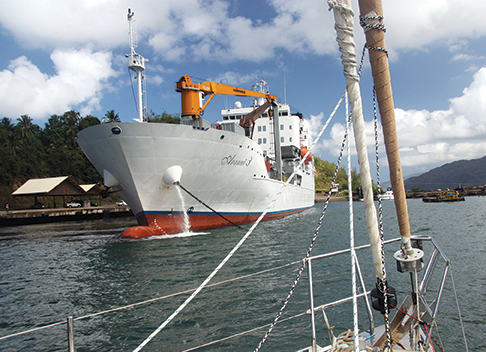
When you enter the harbor passed the breakwater you will see many boats anchored during the cruising season—enough that you may think there isn’t any more room to anchor. There’s always room for one more. The anchoring is mostly all done with bow and stern anchors. The further you can set yourself behind and in the lee of the breakwater, the smoother the anchorage. When you enter the harbor you will see a set of yellow-X range marks on the starboard side land. These make a line across the harbor to the far, rocky wall where there is also a yellow stripe painted. Deeper into the bay from this line you are allowed to anchor. If you anchor in front of this line you will have to move when one of the large island freighters cum-cruise ships arrive. It is fine to drop your bow anchor ahead of the line as long as the boat itself ends up behind it. The ship schedule is fairly well publicized, so you can ask one of the anchored boats if you feel the need to anchor in front of the line. The bay shallows up toward its head. In bad swell conditions, there is a surf break toward the head of the bay—so don’t anchor too shallow.

After anchoring, the most important thing you need to know is that the gas station in the harbor also has a small store that sells fresh baguettes each morning—what a treat. One of the French locals here assured me that the baguettes on Hiva Oa were the best in the Marquesas. From the dinghy dock—bring a stern anchor for your dinghy—to town is about a 45 minute walk around the bay. If there are just two of you walking it is very likely that someone will stop to give you a ride into town. The Marquesians are very friendly—even when there is a language barrier. You will do your fairly informal check-in at the Gendarmerie on the main road in town. The official check-in is completed in Papeete, however this check-in will suffice if you don’t stop in Papeete.
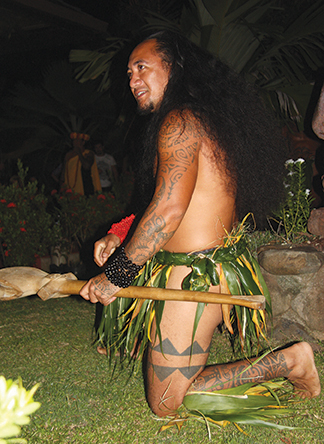
If you decide not to make your landfall in the southern islands, then the next most logical place to land is Baie de Taiohae in Nuka Hiva in the northern islands. This is the main bay and town of Nuka Hiva and sometimes just referred to as Nuka Hiva. The bay is large and very easily entered. It is guarded by the east and west sentinel (Sentinelle de l’este and Sentinelle de l’Ouest), large rocks on either side of the bay entrance. There is room for an infinite number of boats in the bay. This bay is spilt between boats that use bow and stern anchors and those that are bow only. It is large enough that this is not a problem. The swell that enters the bay is sometimes uncomfortable, hence the bow-stern anchoring. There’s a nice quay on the eastern side where you can tie up your dinghy. The Gendarmes are located just off the main concrete street—turn right from the quay road.
DEALING WITH VISAS
If you have a North American passport, then you will be given a standard 90-day visa in French Polynesia. It is possible to obtain a longer stay visa by applying at a French Embassy before you arrive in French Polynesia. The process takes anywhere from a few weeks to a few months. Once you have your visa, you will still need to turn in additional paper work, and pay an additional fee, once you clear in to French Polynesia to complete the long-term visa process. In Nuka Hiva, the office for this is located on the main road; go right from the quay. It is a stone two-story building on your left with numerous flag poles out front and is across the street from the yellow post office building. You’ll meet with Ann-Marie Guigen. She will send your paperwork to Papeete so that you will eventually receive your ‘carte de sejour’ giving you six months or a year in French Polynesia. This may take anywhere from a couple of weeks to a couple of months. Getting your ‘carte de sejour’ is completely independent from clearing-in, so you can still clear-in in Hiva Oa and then later sail north to Nuka Hiva to turn in this paperwork. It is possible to make arrangements to pick up your ‘carte de sejour’ in Papeete.
If you enter on a U.S. or Canadian passport (among others) you will be required to post a bond. The bond is to ensure that you actually leave the islands. After Thor Heyerdahl published the book Fatu Hiva there was a rush of what the locals euphemistically referred to as ‘beachcombers’ who moved to the islands. A more accurate translation of beachcomber would be bums and freeloaders. The bonds were designed to help curtail this problem. The bond can be paid by putting up cash at the bank that will be returned when you check out. The bank reportedly charges a $135 fee for this. Alternately you can show a return airfare from Papeete to your home country or you can use an agent. The agent will issue you a bond letter at a cost of about $125 per person. Of course, these fees may vary from year to year.
With a standard visa you’ll need to allocate your time between the Marquesas, the Tuamotus and the Society islands. Evenly spreading one month a piece is pretty reasonable. Cruisers who are heavy divers will want more time in the Tuamotus, those who need to spend more time fixing their boats will likely spend more time in the Society Islands.
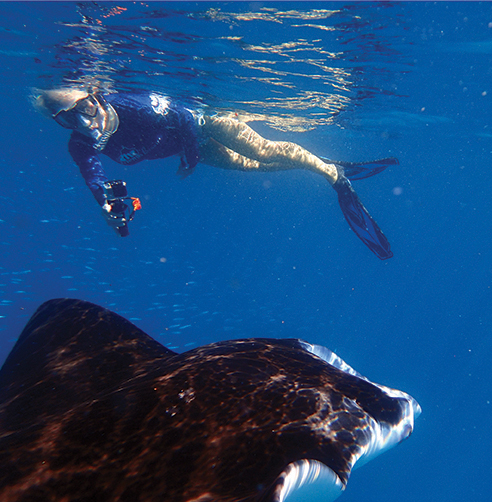
A PERFECT SAILING ROUTE THROUGH THE MARQUESAS
Depending on your inclination, you would start this route landing in Fatu Hiva or sail down after checking-in in Hiva Oa. Starting in the Bay of Virgins, Fatu Hiva, in the southeast of the island chain you would be in the most spectacular anchorage in the Marquesas. Early in the cruising season you could have this bay to yourself. It has steep-to mountains that are covered in green with massive spires shooting toward the sky. The dinghy landing for the village of Hanavave is behind the breakwater providing easy access to shore. The people of the village are friendly and welcome visitors. The men are often excellent carvers and many of the women make Tapa cloth, made from local bark. There are no banks or ATMs here and U.S. dollars are not useful. There is a small store that may take Euros if you haven’t been to Hiva Oa yet to get French Polynesian Francs.
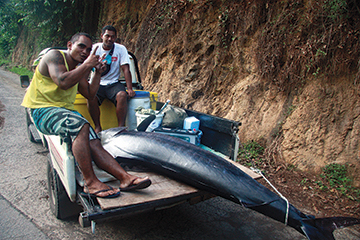
Next stop to the northeast would be the island of Tahuata. There are a few anchorages along the west coast that are interesting in good conditions. The Baie Hanamoenoa on the northwest portion of the island and its neighbor immediately south, are excellent anchorages. It was the best snorkeling and swimming that we had while in the Marquesas—including swimming with local Manta Rays. The bay is large and very protected from the prevailing wind and waves. The coconut plantation onshore behind the sandy beach is cared for by a local named Steven. He enjoys breaking up the isolation of the place by having cruisers around and often hosts barbeques on the beach.
If you haven’t cleared in yet, then your next stop needs to be Atuona on Hiva Oa. To get there you will sail through the pass between Tahauta and Hiva Oa, Canal du Bordelais. The winds funnel through here, but fortunately it is not a long passage. There is a tidal current that floods to the east that you can take advantage of, although it does tend to make the waves more square.

Atuona is a good stop for basic provisioning, fuel (jerry jug from the gas station at the pier) and to check-in as well as to get an internet fix. It is worth doing an island tour to see the ancient Polynesian sites and to pick up some island fruit. The local grapefruit, known as pamplemouse, is a tart-sweet treat. Don’t forget your grapefruit knife. We liked them so much that we purchased a 60 lb bag full before we left for the Tuamotus. Hiva Oa has the best original stone carved Tiki statues in the Marquesas. The anchorage is typically crowded and has a swell going through it, so a few days is usually enough.
If the weather cooperates, there are some anchorages on the north side of Hiva Oa you might want to stop in before heading to the northern island group. Leaving very early in the morning or doing an overnight from anywhere from Tahuata to Hiva Oa will bring you to the main anchorage in Ua Pou. This is on the northeast side of the island, which you wouldn’t normally expect to be protected from the prevailing winds. Baie D’Hakahau is the main town on the island and is protected by a breakwater. You can anchor behind the breakwater close into the pier as long as no ships are scheduled to arrive, otherwise you can anchor in the shallower area near the beach with a bow and stern anchor. The town has a bakery, decent food shops and some interesting local arts.
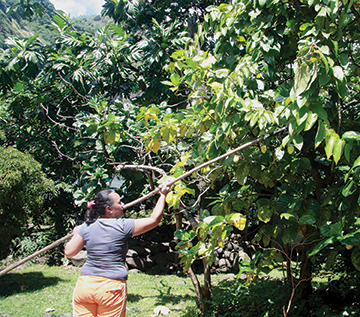
Next up on our downwind sail through the Marquesas would be Nuka Hiva. The primary bay and town is Taiohae. This is the administrative center for the Marquesas. It has decent food shopping, a vegetable market near the quay and a bakery as well as med-moor quay to obtain fuel. A land tour of Nuka Hiva is definitely worthwhile, but you must read (free e-book download) Herman Melville’s Typee before you go. You will tour the old tribal area of Taipivai where the Typee story takes place. The religious sites on Nuke Hiva are impressive, especially the giant banyan trees and the areas reserved for the prisoners who were to become the human sacrifices. There are many other bays on Nuka Hiva well worth exploring, including Daniel’s Bay, a few miles west of Taiohae, Baie Controller (which actually has three bays, including Taipivai) a few miles east and several on the north side of the island if you are so inclined.
If you choose to make your first Marquesan landfall at Nuka Hiva, all is not lost. It is not that hard a passage to get back down to the southern islands, although you will most likely be doing some motoring into the trades. The sail south from Nuka Hiva to Ua Pou is only about 25 miles and is usually easy to sail the entire trip. Then you can do an overnight or leave very early in the morning and sail/motor from Ua Pou to Tahauta. We ended up doing this passage as we needed to meet up with some friends in the southern islands. We burnt some diesel and bounced a bit. Leaving from Tahauta in the southern Marquesas to the Tuamotus usually makes for a good wind angle.
Now that you’ve explored the highlights of the Marquesas you are in a good position for staging your exit to the Tuamotus. It is a three to five day sail southwest to your first Tuamotu atoll. There are a number of choices for your first atoll. We did our first atoll pass into Raroia, but that’s a story for later.
The Marquesas are a fantastic landfall after being at sea for three weeks. It crowns a long passage with a special, never to be forgotten ending. Get out your guide books and your south sea anthologies to fill your passage time while you wait to arrive in one of the friendliest landfalls in the world.
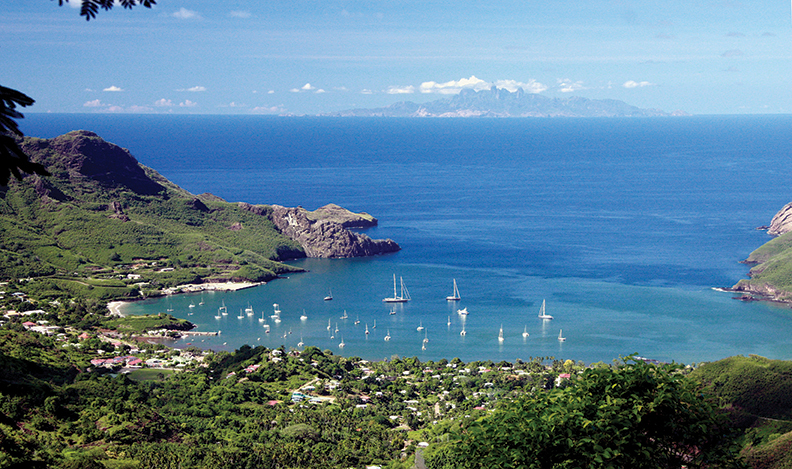
Paul Lever and Chris Hunter have been cruising full-time for the past four years. They’ve ranged from Seattle to Mexico, and Panama to Cape Breton and Nova Scotia. Their Outbound 44, Georgia, is currently in French Polynesia after another successful Canal transit and a visit to the Galapagos. Follow their adventures at svjeorgia.blogspot.com.

